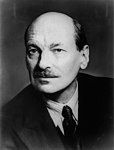| |||||||||||||||||||||||||||||||||||||||||
All 74 Scottish seats to the House of Commons | |||||||||||||||||||||||||||||||||||||||||
|---|---|---|---|---|---|---|---|---|---|---|---|---|---|---|---|---|---|---|---|---|---|---|---|---|---|---|---|---|---|---|---|---|---|---|---|---|---|---|---|---|---|
| |||||||||||||||||||||||||||||||||||||||||
 Results of the 1945 election in Scotland for the county and burgh seats Unionist Labour Independent Labour Party National Liberal Independent Liberal Independent Unionist Communist Party of Great Britain | |||||||||||||||||||||||||||||||||||||||||
A general election was held in the United Kingdom on Thursday 5 July 1945,[1] and all 74 seats in Scotland were contested.[2] Held less than two months following VE Day, it was the first general election since 1935, as general elections had been suspended by Parliament during the Second World War, and counting was not completed until 26 July (three weeks after polling day) to enable those stationed overseas to vote.[1] In Scotland, Labour gained 17 seats to hold a total of 37, winning ten more than the combined total of territorial seats won by parties making up the defeated National Government. When combined with results from across the UK Labour secured a majority of 146, with Clement Attlee replacing Winston Churchill as prime minister.[1]
Scotland was allocated 74 seats in the House of Commons, with 71 territorial seats (32 burgh constituencies and 38 county constituencies). There was also one university constituency, which elected an additional 3 members using the Single Transferable Vote (STV) method.[3] As voters in university constituencies voted under a different system, and in addition to their territorial vote, the results are compiled separately. This practice was abolished by the Representation of the People Act 1948, making this the last election in which plural voting was permitted.
The Liberals, who had during the 1930s suffered a series of splits over the issue of whether to support the National Government, remained fractured. The official Liberal Party lost all its seats, however three "Liberals" who supported continued support of the National Government were elected under the National Liberal lable. A further two MPs were elected as "Independent Liberals". The Independent Labour Party lost one seat, returning 3 MPs. Scotland's only Communist MP, Willie Gallacher, retained his West Fife seat. John Mackie, the sitting Unionist MP for Galloway was refused the Unionist nomination for this election, but gained re-election as an "Independent Unionist". The Conservative whip was restored in 1948 and he continued to represent Galloway until his death.
The Scottish National Party failed to hold Motherwell (the first seat the party had ever gained), which Robert McIntyre had won only a few months earlier in the 1945 Motherwell by-election.
Cite error: There are <ref group=lower-alpha> tags or {{efn}} templates on this page, but the references will not show without a {{reflist|group=lower-alpha}} template or {{notelist}} template (see the help page).
- ^ a b c "Politics 97: 5 July 1945". BBC. Retrieved 26 November 2024.
- ^ As per Boundaries of Parliamentary Constituencies 1885-1972 (ISBN 0-900178-09-4), F. W. S. Craig 1972, except Graig omits indication that the burgh of Renfrew was not entirely within the county of the same name
- ^ "Research Briefing: Voting systems in the UK". Library of the House of Commons. 10 January 2023. Retrieved 26 November 2024.



